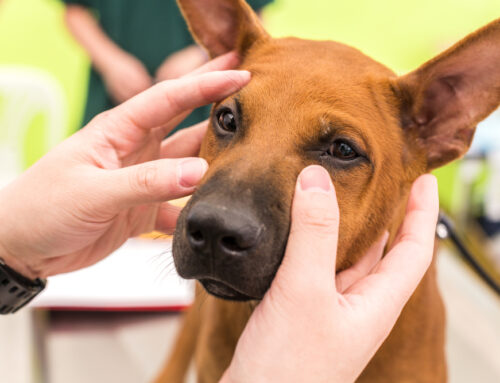Is Your Pet at Risk?
Spotting and Tackling Pet Diabetes
Humans and animals alike face a similar challenge as we age and start to carry a little extra weight around the middle: an increased risk of diabetes. And just like in people, this condition in pets is often preventable with good weight management and a healthy diet.
At Central Kentucky Veterinary Center, we’re here to help you understand the signs, reduce risk, and manage diabetes if it does occur. Your pets aren’t just animals, they’re family. We’re here to guide you every step of the way.
What Is Diabetes in Pets?
Diabetes mellitus occurs when your pet’s body can’t properly regulate blood sugar levels due to either:
- A lack of insulin (Type 1, more common in dogs)
- An inability to use insulin effectively (Type 2, more common in cats)
Insulin acts like a key that helps glucose (sugar) enter cells and provide energy. Without enough insulin—or when insulin doesn’t work properly—glucose builds up in the bloodstream. This can cause damage to organs and lead to serious complications over time.
What Causes Diabetes in Dogs and Cats?
Common Risk Factors in Dogs
- Genetics: Certain breeds (Samoyeds, Miniature Schnauzers, Poodles) are more prone.
- Pancreatic Damage: Inflammation or infections can destroy insulin-producing cells.
- Obesity and Poor Nutrition: Extra weight increases insulin resistance.
Common Risk Factors in Cats
- Obesity: One of the leading contributors to feline diabetes.
- Chronic Pancreatitis: Long-term inflammation can disrupt insulin production.
- Breed Predisposition: Burmese cats are particularly susceptible.
Steroid medications, hormonal imbalances, or stress can also play a role in triggering or worsening diabetes in both dogs and cats.
Why Early Recognition Matters
Diabetes won’t go away on its own—and left untreated, it can become life-threatening. But when caught early, it’s manageable and your pet can continue living a full, happy life.
Early diagnosis helps avoid:
- Painful complications (like cataracts in dogs or nerve damage in cats)
- Emergency hospital visits for diabetic ketoacidosis (DKA)
- Long-term stress for both you and your pet
Signs and Symptoms: What to Watch For
Keep an eye out for these subtle but telling changes:
- Increased Thirst and Urination – You might notice your pet draining their water bowl more often or having accidents indoors.
- Ravenous Appetite with Weight Loss – Eating more than usual but still losing weight is a red flag.
- Lethargy or Weakness – Your pet may seem tired, withdrawn, or just “not themselves.”
- Cloudy Eyes (in Dogs) – A potential sign of cataracts forming.
- Recurring Infections – Such as urinary tract infections, poor skin condition, or lingering wounds.
Want to be proactive at home? This DIY Dog Checkup offers a helpful starting point.
How Diabetes Progresses Without Treatment
If diabetes is missed or ignored, it will worsen—and often faster than expected:
- Early Stage: Thirst, frequent urination, and mild weight loss
- Mid Stage: Dehydration, muscle loss, lethargy, chronic infections
- Advanced Stage: Diabetic ketoacidosis (DKA), cataracts, nerve damage, or even coma
DKA is a medical emergency that requires immediate veterinary attention. Learn more about what to watch for here: Diabetic Emergencies.
How We Diagnose Diabetes in Pets
Getting a clear diagnosis involves:
- Physical Exam: We’ll assess hydration, body condition, and any visible signs.
- Blood Glucose Testing: Elevated blood sugar confirms hyperglycemia.
- Urinalysis: Checks for glucose and ketones in the urine.
- Fructosamine Test: Measures average blood glucose levels over 2–3 weeks.
More on glucose testing can be found via the Morris Animal Foundation.
Treatment: What Managing Diabetes Looks Like
Insulin Therapy
Most pets—especially dogs—will require daily insulin injections. Our team will teach you how to administer and store insulin correctly, and we’ll work together to fine-tune the dosage.
Nutritional Support
- Dogs: High-fiber, low-fat diets help stabilize blood sugar.
- Cats: High-protein, low-carb diets are ideal—some cats may even go into remission!
Meal timing is crucial: feeding your pet on a consistent schedule alongside insulin helps regulate glucose levels.
Monitoring & Adjustments
Regular check-ins and blood glucose curves help us track progress and prevent complications. Your vet will let you know when adjustments are needed.
Daily Life with a Diabetic Pet
Caring for a diabetic pet can feel overwhelming at first—but it gets easier. The keys to success are:
- Consistency: Stick to a routine for meals, insulin, and exercise.
- Monitoring: Watch for signs of low blood sugar (lethargy, tremors, confusion). Blood glucose testing can be done at home if you are comfortable and your pet is cooperative- ask us how!
- Patience & Support: Emotional ups and downs are normal—don’t hesitate to ask for help.
Want to learn about clinical signs, diagnosis, treatment, and prevention of diabetes in pets? Here’s a great resource from the AVMA.
Can Diabetes Be Prevented?
Not always—but you can reduce the risk by:
- Maintaining a healthy weight
- Feeding a balanced, high-quality diet
- Exercising regularly
- Avoiding long-term use of steroids without guidance
- Scheduling regular vet checkups for early detection
Our team is happy to discuss a personalized plan. Contact us here to learn more.
Frequently Asked Questions
Can diabetes be cured?
In dogs, it’s usually a lifelong condition. Some cats may go into remission, especially with early intervention and diet changes.
Is it expensive to treat?
There are ongoing costs (insulin, syringes, vet visits), but pet insurance or wellness plans can help. We’ll work with you to create a manageable care plan. Emergencies are a huge expense that can be prevented by keeping strict diets and routines.
What happens if I miss an insulin dose?
Don’t double up. Give the next scheduled dose as usual and monitor your pet closely. Always call us if you’re unsure.
You’re Not Alone—We’re Your Partner in Pet Wellness
A diabetes diagnosis can feel overwhelming—but with the right care, your pet can thrive. At Central Kentucky Veterinary Center, we’re here to help you navigate each step—from diagnosis to daily care—with compassion and clarity.
If you have questions, suspect your pet is showing signs of diabetes, or simply want to stay proactive, schedule an appointment today. We’re ready to help you keep your pet healthy, happy, and by your side for years to come.








Leave A Comment